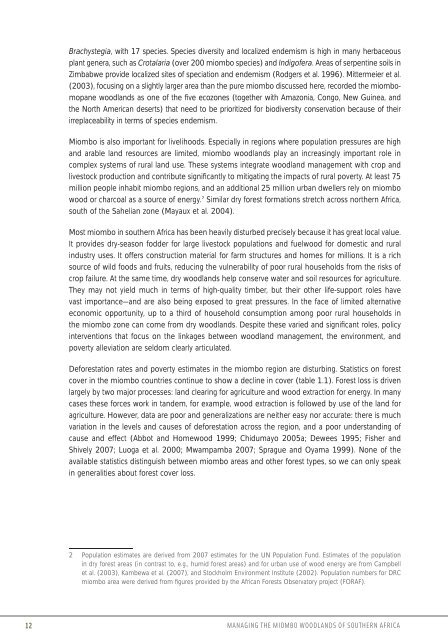Managing the Miombo Woodlands of Southern Africa - PROFOR
Managing the Miombo Woodlands of Southern Africa - PROFOR
Managing the Miombo Woodlands of Southern Africa - PROFOR
You also want an ePaper? Increase the reach of your titles
YUMPU automatically turns print PDFs into web optimized ePapers that Google loves.
Brachystegia, with 17 species. Species diversity and localized endemism is high in many herbaceous<br />
plant genera, such as Crotalaria (over 200 miombo species) and Indig<strong>of</strong>era. Areas <strong>of</strong> serpentine soils in<br />
Zimbabwe provide localized sites <strong>of</strong> speciation and endemism (Rodgers et al. 1996). Mittermeier et al.<br />
(2003), focusing on a slightly larger area than <strong>the</strong> pure miombo discussed here, recorded <strong>the</strong> miombomopane<br />
woodlands as one <strong>of</strong> <strong>the</strong> fi ve ecozones (toge<strong>the</strong>r with Amazonia, Congo, New Guinea, and<br />
<strong>the</strong> North American deserts) that need to be prioritized for biodiversity conservation because <strong>of</strong> <strong>the</strong>ir<br />
irreplaceability in terms <strong>of</strong> species endemism.<br />
<strong>Miombo</strong> is also important for livelihoods. Especially in regions where population pressures are high<br />
and arable land resources are limited, miombo woodlands play an increasingly important role in<br />
complex systems <strong>of</strong> rural land use. These systems integrate woodland management with crop and<br />
livestock production and contribute signifi cantly to mitigating <strong>the</strong> impacts <strong>of</strong> rural poverty. At least 75<br />
million people inhabit miombo regions, and an additional 25 million urban dwellers rely on miombo<br />
wood or charcoal as a source <strong>of</strong> energy. 2 Similar dry forest formations stretch across nor<strong>the</strong>rn <strong>Africa</strong>,<br />
south <strong>of</strong> <strong>the</strong> Sahelian zone (Mayaux et al. 2004).<br />
Most miombo in sou<strong>the</strong>rn <strong>Africa</strong> has been heavily disturbed precisely because it has great local value.<br />
It provides dry-season fodder for large livestock populations and fuelwood for domestic and rural<br />
industry uses. It <strong>of</strong>fers construction material for farm structures and homes for millions. It is a rich<br />
source <strong>of</strong> wild foods and fruits, reducing <strong>the</strong> vulnerability <strong>of</strong> poor rural households from <strong>the</strong> risks <strong>of</strong><br />
crop failure. At <strong>the</strong> same time, dry woodlands help conserve water and soil resources for agriculture.<br />
They may not yield much in terms <strong>of</strong> high-quality timber, but <strong>the</strong>ir o<strong>the</strong>r life-support roles have<br />
vast importance—and are also being exposed to great pressures. In <strong>the</strong> face <strong>of</strong> limited alternative<br />
economic opportunity, up to a third <strong>of</strong> household consumption among poor rural households in<br />
<strong>the</strong> miombo zone can come from dry woodlands. Despite <strong>the</strong>se varied and signifi cant roles, policy<br />
interventions that focus on <strong>the</strong> linkages between woodland management, <strong>the</strong> environment, and<br />
poverty alleviation are seldom clearly articulated.<br />
Deforestation rates and poverty estimates in <strong>the</strong> miombo region are disturbing. Statistics on forest<br />
cover in <strong>the</strong> miombo countries continue to show a decline in cover (table 1.1). Forest loss is driven<br />
largely by two major processes: land clearing for agriculture and wood extraction for energy. In many<br />
cases <strong>the</strong>se forces work in tandem, for example, wood extraction is followed by use <strong>of</strong> <strong>the</strong> land for<br />
agriculture. However, data are poor and generalizations are nei<strong>the</strong>r easy nor accurate: <strong>the</strong>re is much<br />
variation in <strong>the</strong> levels and causes <strong>of</strong> deforestation across <strong>the</strong> region, and a poor understanding <strong>of</strong><br />
cause and effect (Abbot and Homewood 1999; Chidumayo 2005a; Dewees 1995; Fisher and<br />
Shively 2007; Luoga et al. 2000; Mwampamba 2007; Sprague and Oyama 1999). None <strong>of</strong> <strong>the</strong><br />
available statistics distinguish between miombo areas and o<strong>the</strong>r forest types, so we can only speak<br />
in generalities about forest cover loss.<br />
2 Population estimates are derived from 2007 estimates for <strong>the</strong> UN Population Fund. Estimates <strong>of</strong> <strong>the</strong> population<br />
in dry forest areas (in contrast to, e.g., humid forest areas) and for urban use <strong>of</strong> wood energy are from Campbell<br />
et al. (2003), Kambewa et al. (2007), and Stockholm Environment Institute (2002). Population numbers for DRC<br />
miombo area were derived from fi gures provided by <strong>the</strong> <strong>Africa</strong>n Forests Observatory project (FORAF).<br />
12 MANAGING THE MIOMBO WOODLANDS OF SOUTHERN AFRICA

















